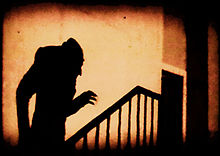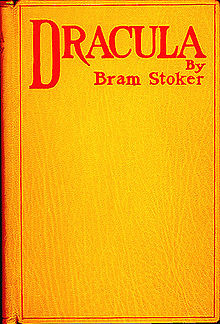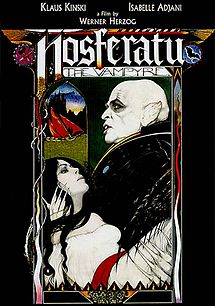English 110: Writing and Research
Theme:� The Vampire in
Folklore, Literature, and Film

Instructors: Dr.
Robert S. Carlisle
Section: (8) from January 05 to March 19, 2015
Office:� 201E Faculty Tower
Telephone Number:� 654-2127
Office Hours:� 10:00 to 12:30 on Monday and Wednesday
Email Address: rcarlisle@csub.edu
Required
Texts
Dundes, A. (Ed.). (1998).� The Vampire: A Casebook. �Madison, WI: The University of Wisconsin Press
(ISBN: 0-299-15924-8).
Perkowski, J. (2006).� Vampire Lore:� From the Writings of Jan Perkowski.� Bloomington, IN:� Slavica
Publishers.� (ISBN: 0-89357-331-0).
Stoker,
B. (1997)� Dracula.� New York:�
Norton.� (ISBN:� 978-0-393-97012-8).
Quick Access
Other Readings
Students
will be able to get other readings online for free.
Course
Overview & Policy Statements
Prerequisite
A total English Placement Test
score of 147 or higher OR a grade of C- or higher in English 100 or its
equivalent OR an English 110 EQE score OR other equivalent test scores.
To
Satisfy the General Education Requirement
Students must earn a grade of
C or higher in English 110 to satisfy the General Education requirement for A2
(Writing and Reading).� This grade is
also a prerequisite for upper-division composition courses and the Graduation
Writing Assessment Requirement exam.
Successful
Completion of English 110
To be eligible for a C in
English 110, students must earn a C or higher on at least one in-class writing
assignment and a C average on all other course assignments.
Course Description
Practice in expository
writing, including the college term paper. Includes frequent
reading and writing assignments.
Course Learning Outcomes
At the end of English 110, students should be able to
demonstrate the following skills:
Goal 1:����� Reading Skills
A2-1:�������� Students will critique a writer�s rhetorical choices (e.g., bias,
rhetorical modes, organization, diction, etc.) and logic.
Goal 2:� Writing Skills
A2-2A:����� Students
will create proficient thesis statements for various types of writing tasks.
����� A2-2B:����� Students
will use discourse-appropriate syntax.
A2-2C:����� Students
will use logical reasoning, at the appropriate level, to develop and organize
ideas.
Goal 3:� Research Skills
����� A2-3A:����� Students
will find diverse, reputable sources for an academic research paper.
A2-3B:����� Students will correctly use summary,
paraphrase, and direct quotes to synthesize sources into an academic research
paper.
Attendance
Policy
Because mastering skills in
writing requires regular, sustained effort, you should attend your composition
classes regularly and punctually.� If you
have more than two absences, you should not expect to receive a passing grade.
Waiting
List Policy
On a waiting list, you are
eligible for a place in the class if you
1. come
to every class and
2. turn in the work while you are there.
Being on a waiting list does
not guarantee you a place in the class.�
It simply means you are welcome to wait for an opening in the class if
you so desire.� If no one drops out of
the course, then no students can add.
As a result, you should be
aware of the last day to add and have a back-up choice if you need another
class.� This plan is especially important
for financial aid recipients and for F-1 and J-1 visa holders, who must carry a
full load to receive their financial aid.�
Being on a waiting list does not
count as a class toward a full load.
Instructor-Initiated
Drop Policy
Many students are trying to
get into composition courses.� As a
result, this class is subject to the policy on instructor-initiated drops.� If the class is full and has a waiting list,
the instructor has the right to administratively drop you from class by the end
of the second week of the term if you have missed three consecutive class
sessions and have not contacted the instructor.�
However you should not assume that you will be automatically dropped
from this course if you have not attended.
Exercises
from MyWritingLabPlus
MyWritingLabPlus is
designed to help you with writing & grammar necessary for persuasive,
logical, & effective writing. This online program allows you access to work
on grammar, mechanics, writing, & research skills at your own pace, on your
own time.� MyWritingLabPlus
supports different learning styles as well, utilizing audio files, videos,
& interactive exercises.
When you log in, there will
be a link to this course.� For this
course, you will first complete the Path Builder.� After you finish the Path Builder, you are
required to master the 10 topics. To master a topic, you must earn a score of
80% or higher on the Recall 1, Recall 2, and Apply activities for each of the
following topics:
�
Module W3: Punctuation, Mechanics,
and Spelling
�
����������� W3.1
Commas
�
����������� W3.2
Final Punctuation
�
����������� W3.3
Quotation Marks
�
����������� W3.4
Semicolons, Colons, Dashes, and Parentheses
�
����������� W3.5
Apostrophes
�
����������� W3.7
Capitalization
�
����������� W3.8
Spelling
�
�
Module W2: Sentence Structure
�
����������� W2.1
Sentence Structure
�
����������� W2.2
Fragments
�
�
Module W4: Usage and Style
�
����������� W4.2
Easily Confused Words
Website URL: ����������� http://csub.mylabsplus.com
Username: ����� Student ID# (e.g., 000123456)
Password: ������ The first time you log in, your password
will be your full birth date (e.g., if your birthday is November 9, 1993, then
your password would be 11091983).� You
can change this password after you log in the first time.
Students must turn in a
completed set of exercises by midnight on the Sunday of each week.� Follow the order of exercises above.
Research
Paper
The
purpose of English 110 is to enable students to write a research paper of
quality and depth.� Upon completion of
the paper, students will have the knowledge to write the research papers that other
courses will require.�
Accessibility
"California
State University, Bakersfield is committed to providing equal access to
Web-based information
for people with disabilities. This is in accordance with Section 504 of the
1973 Rehabilitation Act, Section 508
of the Rehabilitation Act Amendment of 1998 and the 1990 Americans with
Disabilities Act, and Executive Order 926 of
California State University."
To achieve the goal of universal accessibility, CSUB uses Blackboard as its Learning Management System (LMS), the first LMS to receive the Non-visual Accessibility Gold Certification by The National Federation of the Blind. Students can read more about Blackboard's guarantee of accessibility and its accessibility programs at its website.
Technical Support
For the most part, students will not need any special programs to view the content of the class or complete assignments. Students will need to view several YouTube videos and one MP4 video, meaning that students will need a media player to view the latter. If students have difficulty with the content of the class, they need to contact the instructor, preferably using the 'Discussion Board' so that other students can see both the question and the answer.
If students have any technical problems with Blackboard, then they need to contact the Blackboard Help Desk, either by telephone (661) 654-2315 or by email lmssupport@csub.edu. Students may also go to the E-Learning Services Building on the east side of the Walter Stiern Library.
The Theme for the Class

The theme for this section of English 110 is the vampire.� The class is divided into three major sections:� the vampire in folklore, the vampire in literature, and the vampire in film.� The first section of the class begins with an introduction to folklore and continues with the students discovering the folkloric motifs involving the vampire.� In the first section, students will also learn about the great vampire epidemic of the 18th century, the classification of vampires, �historical� vampires, corpse medicine, the decomposition of corpses, and the possible psychological, social, and religious reasons leading to beliefs in vampires�in other words, we�re going to have a bloody good time.�
In the second and third sections of the class, we will continue to examine the vampire motifs and compare the ones in literature and film with those is folklore.� Students will also study vampire literature and film as Gothic entertainment.� In the second section of the class, students will read the following 19th century works:

� The Vampyre by John William Polidori
� Selections from Varney the Vampire
� Selected short stories to be announced later in class.
� Carmilla by Joseph Sheridan Le Fanu.
� Dracula by Bram Stoker
In the third section of the course, we will be seeing two or more films in class from those listed below:

� Nosferatu (1922)
� Dracula (1931)
� Nosferatu: The Vampyre (1979)
� Bram Stoker�s Dracula (1992)
� One mystery movie to be announced (if time allows)
Though the last two sections of the class have some required readings and films, students will also be able to select other readings and films that particularly interest them.� I ask all students to read at least one modern vampire novel to identify the motifs and to view at least one additional film for the same reason.
Evaluation
Students must complete a number of requirements for the course. First, they are required to participate in three blogs where they will insert motifs (narrative elements) about vampires in folklore, literature and film.� Each major section of the class has one blog consisting of six broad categories of motifs and students must insert three specific examples in each category.� During the first week of class, the instructors will provide explicit instructions for how to enter the motifs into the blogs.� As illustrated in the table below, each blog is worth 10% of the final grade, for a total of 30% given that there are three blogs.� Students must complete the blogs by certain dates, which are found in the schedule.�
The second requirement is for students to write a term paper on a topic of their choice.� The instructor has provided some suggested� Topics for the Term Paper and Instructions for writing the term papers are also available.� The grade on term papers constitutes 40% of the final grade.
The final grade will be calculated according to the following schema.
|
Evaluation Task |
Percentage of Grade |
Deadlines |
|
Folklore Blog |
10% |
January 22 |
|
Literature Blog |
10% |
February 21 |
|
Film Blog |
10% |
March 15 |
|
MyWritingLabPlus |
05% |
Various Dates |
|
In-class Essay |
10% |
Various Dates |
|
Documented Essay |
10% |
March 04 |
|
Annotated Bibliography |
05% |
March 04 |
|
Term Paper |
30% |
March 11 |
|
Final Examination |
10% |
TBA |
Grading Policy
We will assign final grades according to the following schema:
|
The final average will be calculated by averaging the grades of the three requirements discussed above.
Communicating with Other Students and the Instructor
Students can communicate with one another by using the Discussion Topics, Mail, and Chat functions in the Communications folder in Blackboard.� When writing any questions or comments, students are expected to follow the rules of netiquette by avoiding profanity, sarcasm, and ridicule.� All entries under Discussion Topics are public, and students should place all questions about course content in the appropriate folder in Discussion Topics.� If students do not answer a question posted by another student within 24 hours, the instructor will reply.� Postings in Mail are private, and by using this feature, students may communicate with one another without fear of anyone else viewing what has been written.� Students may also communicate privately with one another using the Chat function, which the instructor with never enter.
To communicate with the instructor, students should use Mail within Blackboard, not the instructor�s campus email account.� The instructor makes a dedicated effort to respond to all student email inquiries within 24 hours.
Getting to the Course
The course is located on a CSUB server running Blackboard, the web-based teaching software used to design the course. To get into Blackboard, students need a userid and a password, which they should already know. Students will be able to enroll into their appropriate section of English 110 a week before classes begin. The instructor will send out an email message with the enrollment code on it.
Important University Dates
January 26, 2015: Last date to withdraw without a "W" being
recorded.
February 23, 2015: Last date to withdraw for a serious and compelling reason.